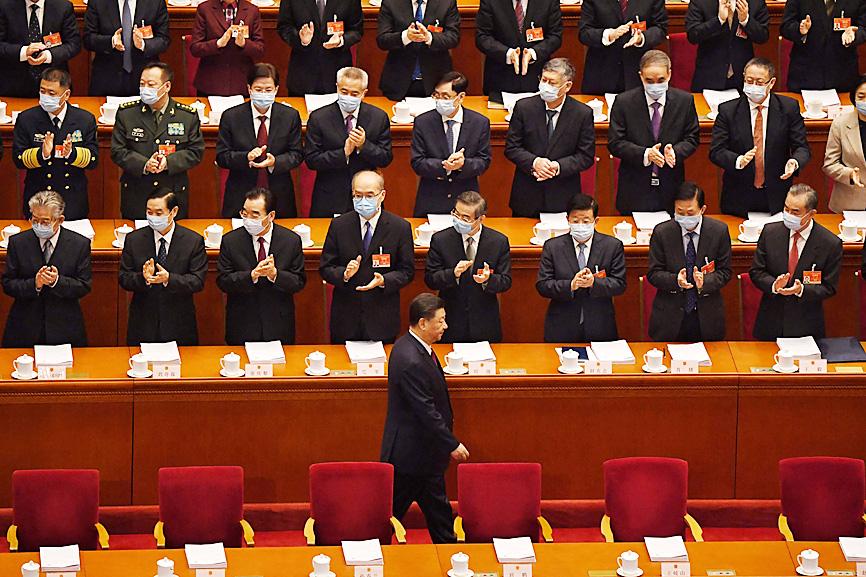China yesterday projected defense spending growth of 6.8 percent this year, while saying that it would deter any “separatist activity” from Taiwan, but remain committed to promoting cross-strait relations.
Beijing has increased its military activity near Taiwan in the past few months, responding to what it calls “collusion” between Taipei and Washington, the nation’s main international backer and arms supplier.
At the opening of the annual Chinese National People’s Congress, Chinese Premier Li Keqiang (李克強) said that Beijing stands by its “one China” principle, which states that Taiwan is part of China.

Photo: AFP
China remains committed “to promoting the peaceful growth of relations across the Taiwan Strait and China’s reunification,” he told about 3,000 delegates at the Great Hall of the People in Beijing.
“We will remain highly vigilant against and resolutely deter any separatist activity seeking Taiwan independence,” Li said.
“We will promote exchanges, cooperation and integrated development across the Taiwan Strait. Together we can shape a bright future of rejuvenation for our great nation,” he added.
The Mainland Affairs Council in Taipei responded by urging China to begin “benign” interactions with it to gradually resolve disagreements through communications.
The council said the government would continue to resolutely defend its sovereignty and Taiwan’s democracy and freedom, and that healthy and orderly exchanges were better than “enforced” pressure.
Also at the conference, the Chinese Ministry of Finance said it would bolster the country’s defense spending 6.8 percent this year, the largest gain since 2019, amid tensions with the US and key neighbors.
Military expenditure is expected to climb to 1.35 trillion yuan (US$208.03 billion) in the coming year, the ministry said.
The figure compares with a projected rise of 1.8 percent in budgeted fiscal spending.
A Bloomberg calculation of the latest defense budget number shows spending for this year would actually rise 6.9 percent.
“We will provide stronger financial guarantees to vigorously support the modernization of national defense and the armed forces, and help China’s defense capabilities rise in step with its economic strength,” the ministry said in a report.
The spending boost comes after China sparred with India on its border and as the nation seeks to modernize its military to make it more competitive with the US.
“We will boost military training and preparedness across the board, make overall plans for responding to security risks in all areas and for all situations, and enhance the military’s strategic capacity to protect the sovereignty, security and development interests of our country,” Li said.
“Considering Beijing’s threat perceptions and goal of achieving military modernization by 2035, I’d expect defense spending to continue to be a priority,” said Meia Nouwens, a senior fellow at the International Institute for Strategic Studies.

The US government has signed defense cooperation agreements with Japan and the Philippines to boost the deterrence capabilities of countries in the first island chain, a report by the National Security Bureau (NSB) showed. The main countries on the first island chain include the two nations and Taiwan. The bureau is to present the report at a meeting of the legislature’s Foreign Affairs and National Defense Committee tomorrow. The US military has deployed Typhon missile systems to Japan’s Yamaguchi Prefecture and Zambales province in the Philippines during their joint military exercises. It has also installed NMESIS anti-ship systems in Japan’s Okinawa

‘WIN-WIN’: The Philippines, and central and eastern European countries are important potential drone cooperation partners, Minister of Foreign Affairs Lin Chia-lung said Minister of Foreign Affairs Lin Chia-lung (林佳龍) in an interview published yesterday confirmed that there are joint ventures between Taiwan and Poland in the drone industry. Lin made the remark in an exclusive interview with the Chinese-language Liberty Times (the Taipei Times’ sister paper). The government-backed Taiwan Excellence Drone International Business Opportunities Alliance and the Polish Chamber of Unmanned Systems on Wednesday last week signed a memorandum of understanding in Poland to develop a “non-China” supply chain for drones and work together on key technologies. Asked if Taiwan prioritized Poland among central and eastern European countries in drone collaboration, Lin

NO CONFIDENCE MOTION? The premier said that being toppled by the legislature for defending the Constitution would be a democratic badge of honor for him Premier Cho Jung-tai (卓榮泰) yesterday announced that the Cabinet would not countersign the amendments to the local revenue-sharing law passed by the Legislative Yuan last month. Cho said the decision not to countersign the amendments to the Act Governing the Allocation of Government Revenues and Expenditures (財政收支劃分法) was made in accordance with the Constitution. “The decision aims to safeguard our Constitution,” he said. The Constitution stipulates the president shall, in accordance with law, promulgate laws and issue mandates with the countersignature of the head of the Executive Yuan, or with the countersignatures of both the head of the Executive Yuan and ministers or

CABINET APPROVAL: People seeking assisted reproduction must be assessed to determine whether they would be adequate parents, the planned changes say Proposed amendments to the Assisted Reproduction Act (人工生殖法) advanced yesterday by the Executive Yuan would grant married lesbian couples and single women access to legal assisted reproductive services. The proposed revisions are “based on the fundamental principle of respecting women’s reproductive autonomy,” Cabinet spokesperson Michelle Lee (李慧芝) quoted Vice Premier Cheng Li-chiun (鄭麗君), who presided over a Cabinet meeting earlier yesterday, as saying at the briefing. The draft amendment would be submitted to the legislature for review. The Ministry of Health and Welfare, which proposed the amendments, said that experts on children’s rights, gender equality, law and medicine attended cross-disciplinary meetings, adding that